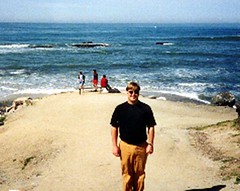Simon's comment linked to in the last post got me to thinking about the qualities of televised music in the US, both before and after the MTV "revolution" as first espoused by the Buggles. At some level, Reynolds is right about the ways in which alternative musics (especially of the post-punk late 70s/early 80s variety) charted in Britain and thus were allowed to have appearances on mainstream media outlets that impacted at a national level in a way unimaginable in the States. Much of this has little to do with differing national characters with respect to the mainstream and much more to do with the relative size and homogeneity of the two countries as well as the fact that cable interpenetration of the UK "terrestrial" market came much later and has still not reached market shares or channel variety similar to that in America.
However, there have been moments in which the best in US music (outside the mainstream) has appeared on TV, either live or in video form. One thinks of some of the classic Don Cornelius Soul Train episodes, now easily the longest continuously running music show (even if the new hosts are picked for their fly soap opera pecs and not their silky or booming dj voices). Regionally there were a bunch of music shows, cable access or otherwise, that showcased local and non-mainstream music. One of my favorites was "Solid in Sum-ma-ville" and "Wikked in Woo-stah" - Boston's mid-1980s commercial video channel V-66.
Perhaps the greatest irony of America in the 1980s was that cable penetrated the red state heartland much more rapidly than it did the large urban blue state coastal enclaves. Possibly, of course, because places like New York, Boston, and San Francisco had a plethora of free TV options on both UHF and VHF frequencies but also because antenna technology was still catching up with high rise reality. While I lived in Cambridge, MA from September 1981 to July 1985, I never had access to MTV. So instead I got my video fix from V-66. MTV was all powerful in those days and actually played primarily videos (one wonders why it hasn't changed its name now that music figures so little in the programming scheme but I digress). MTV acted like the 800 lb gorilla and would often pull videos if it didn't get exclusives. The upshot was a station like V-66 had to scramble for programming fodder if it were going to air 24-7. They looked in two specific directions: locally and globally (specifically across the Atlantic to the UK). V-66 was famous for airing obscure British bands and their videos like the black and white home-movie-quality "How Soon is Now?" by The Smiths, featuring Morrisey in all his NHS spectacle, faux hearing-aid glory, The Art of Noise's stylishly robotic "Close (to the Edit)", and The Cult's statuesque "She Sells Sanctuary." V-66 actually beat MTV to the punch on a-ha's "Take on Me", though I'm not sure that's really a positive. Favorite videos from local artists included 'til tuesday, Lizzie Borden and the Axes, and The Lyres. V-66 was also famously creative; when Prince decided not to make any more videos (a decision he not surprisingly revoked later), the station created a "Raspberry Beret" video featuring an overhead shot of the vinyl record playing interspersed with various bits of album art. If only we could return to such pseudo-guerilla TV. For those who remember, now's the time to throw the Winston "Flying V" salute.
While there have been long running roots for televised pop music in the US (think shows like the syndicateed American Bandstand, NBC's Hullabaloo!, and ABC's Shindig!), there really haven't been the great live on TV venues that there were in Britain like TOTP and The Old Grey Whistle Test. Instead late night has been the locus for televised music in the US, both with the musical act at the end of the talk show routine as well as a series of either syndicated or network shows like Don Kirshner's Rock Concert (the former) and Friday Night Videos and Saturday Night presented by David Sanborn and Jools Holland (the latter).
The exception which proves the rule about the banality of televised music in the US generally, of course, is the show now commonly known as The Ed Sullivan Show but originating as The Toast of the Town - the place where many people first saw "Elvis, Beatles and The Rolling Stones" but also such middlebrow pablum as Topo Gigio, Charro, and Danny Davis & the Nashville Brass. We come full circle vis-a-vis televised music in the US with the Beastie Boys live performance of "Ch-Check It Out" on CBS's Late Show with David Letterman to celebrate the release of To the 5 Boroughs on June 15, 2004. They began emerging from the 53rd St. ("Feelin' almost Groovy") subway station, walked down the middle of some Manhattan streets, and ended emerging with a bang on the stage of the Ed Sullivan Theater. Now that's live televised music!
Saturday, March 11, 2006
Subscribe to:
Post Comments (Atom)

No comments:
Post a Comment